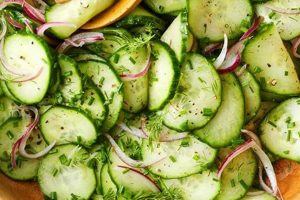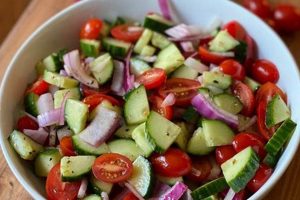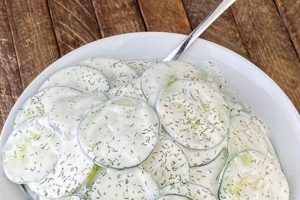This refreshing dish combines the sweetness of watermelon and the coolness of cucumber with the salty tang of feta cheese. A simple vinaigrette often enhances the flavors, and additions like mint, red onion, or black olives can add complexity. Variations exist, showcasing the adaptability of this summer staple, from grilled halloumi substitutions to different herbs and spices.
The combination of hydrating ingredients makes this type of salad ideal for warm weather. The contrasting textures and flavors provide a balanced sensory experience. Furthermore, the readily available ingredients and simple preparation make it a convenient and healthy option. This salad’s versatility allows for adaptation to dietary needs and preferences, easily accommodating vegan or gluten-free diets with ingredient substitutions. Its popularity has risen steadily, reflecting increasing consumer demand for fresh, flavorful, and healthy meal options.
Further exploration will cover specific ingredient selections, preparation techniques, variations, and nutritional information, offering a complete guide to creating and enjoying this culinary delight.
Tips for a Perfect Summer Salad
Creating a truly exceptional salad involves attention to detail and an understanding of the interplay of flavors and textures. These tips offer guidance for achieving optimal results.
Tip 1: Ingredient Selection: Opt for ripe, seedless watermelon for optimal sweetness and texture. Choose firm cucumbers and high-quality feta cheese, preferably stored in brine.
Tip 2: Preparation: Chill the watermelon and cucumber before preparation for enhanced refreshment. Cube ingredients uniformly for even distribution of flavor and appealing presentation.
Tip 3: Balancing Flavors: A simple vinaigrette, often composed of olive oil, lemon juice, salt, and pepper, complements the inherent flavors of the ingredients. A touch of sweetness, such as a drizzle of honey or a pinch of sugar, can balance the acidity.
Tip 4: Adding Complexity: Fresh herbs, such as mint or dill, elevate the flavor profile. Thinly sliced red onion or Kalamata olives introduce contrasting savory notes.
Tip 5: Serving and Storage: Serve the salad immediately after preparation for the crispest texture. If storing, keep ingredients separate and combine just before serving to prevent sogginess.
Tip 6: Customization: Adapt the recipe to individual preferences by incorporating grilled halloumi for a savory variation or adding other seasonal fruits like berries or peaches.
Attention to these details elevates a simple combination of ingredients into a memorable culinary experience. Experimentation with flavors and presentation allows for personalized variations.
By understanding the interplay of ingredients and techniques, one can confidently create a delightful and refreshing salad suited to any occasion.
1. Fresh, High-Quality Ingredients
The success of a cucumber watermelon feta salad hinges on the quality of its ingredients. Freshness is paramount, directly impacting the flavor, texture, and overall enjoyment of the dish. Subpar ingredients diminish the salad’s vibrancy and can even compromise its nutritional value. This section explores the crucial role of ingredient quality in this simple yet elegant summer salad.
- Watermelon:
Ripe, in-season watermelon provides the foundation of sweetness. A deep red color, firm texture, and a sweet aroma indicate ripeness. Choosing pre-cut watermelon should prioritize vibrant color and absence of dryness or sliminess. The watermelon’s sweetness balances the salty feta and the acidic vinaigrette.
- Cucumber:
Firm cucumbers with smooth skin contribute a refreshing coolness. Avoid those with blemishes or soft spots. English cucumbers, known for their thin skin and minimal seeds, are a popular choice. The cucumber’s subtle flavor and crisp texture contrast beautifully with the watermelon.
- Feta Cheese:
Authentic feta, traditionally made from sheep’s milk or a blend of sheep and goat milk, offers a tangy, salty complexity. Stored in brine, it retains optimal moisture and flavor. Crumbled feta distributes evenly throughout the salad, ensuring each bite contains its characteristic tang. The feta’s saltiness is a crucial counterpoint to the sweet watermelon.
- Herbs and Aromatics:
Fresh herbs like mint, dill, or basil add depth and complexity. Vibrant green color and a fragrant aroma indicate freshness. Other aromatics, such as thinly sliced red onion, introduce pungent notes that further enhance the flavor profile. These additions elevate the salad beyond the basic combination of core ingredients.
The interplay of these high-quality ingredients creates a symphony of flavors and textures. Prioritizing freshness elevates the salad from a simple combination of components to a vibrant and refreshing culinary experience. Ingredient quality is thus not merely a desirable attribute but a fundamental requirement for a truly exceptional cucumber watermelon feta salad.
2. Balanced Flavor Profile
A balanced flavor profile is essential to a successful cucumber watermelon feta salad. This balance hinges on the interplay of sweet, salty, acidic, and herbaceous notes. The inherent sweetness of ripe watermelon provides the foundation. This sweetness is offset by the salty tang of feta cheese, creating a fundamental flavor contrast. Acidity, typically introduced through a vinaigrette with lemon juice or vinegar, brightens the flavors and prevents the salad from becoming overly sweet. Fresh herbs, such as mint or dill, contribute herbaceous complexity, rounding out the profile. A lack of balance, such as excessive sweetness or saltiness, can detract significantly from the overall enjoyment. For instance, insufficient acidity can result in a cloying sweetness, while too much feta can overpower the delicate flavors of the watermelon and cucumber. Therefore, achieving a harmonious balance is crucial.
Consider a specific example. A vinaigrette made solely with olive oil and lemon juice may provide insufficient complexity. Adding a touch of honey or maple syrup introduces a nuanced sweetness that complements the watermelon while balancing the lemon’s tartness. Similarly, incorporating a pinch of red pepper flakes adds a subtle heat that further enhances the flavor profile. These seemingly minor adjustments exemplify the significant impact of carefully balancing flavors. The interplay of these elements elevates the salad from a simple combination of ingredients to a complex and satisfying culinary experience.
Understanding the importance of a balanced flavor profile provides a framework for creating a truly exceptional cucumber watermelon feta salad. It allows for informed choices regarding ingredient selection, proportioning, and the incorporation of additional flavors. This knowledge empowers one to confidently adapt the recipe to individual preferences while maintaining the essential harmony of sweet, salty, acidic, and herbaceous notes. This careful orchestration of flavors ultimately determines the salad’s success, transforming a simple dish into a memorable culinary creation.
3. Proper Preparation Techniques
Proper preparation techniques are essential for maximizing the flavor, texture, and overall quality of a cucumber watermelon feta salad. These techniques extend beyond simply combining ingredients; they involve careful consideration of each component’s characteristics and how they interact within the finished dish. The impact of proper preparation manifests in several key areas.
Cutting Techniques: Uniformly sized pieces of watermelon, cucumber, and feta ensure even flavor distribution and contribute to an aesthetically pleasing presentation. Large chunks of watermelon, for example, can overwhelm other flavors, while unevenly sized feta crumbles lead to inconsistent saltiness. Precise cutting techniques mitigate these issues. Dicing the watermelon into bite-sized pieces allows for easy consumption and even distribution of its sweetness. Similarly, thinly slicing red onion, if used, minimizes its pungent bite, allowing it to integrate harmoniously with the other ingredients. These seemingly minor details significantly impact the overall sensory experience.
Temperature Control: Chilling the watermelon and cucumber before preparation enhances their refreshing qualities. Serving the salad cold amplifies the contrast between the cool ingredients and the ambient temperature, making it particularly appealing in warm weather. Conversely, using room-temperature ingredients diminishes this effect. Additionally, allowing the feta to come to room temperature slightly before serving can enhance its flavor and soften its texture, allowing it to blend more seamlessly with the other components.
Timing: Combining ingredients immediately before serving preserves the crispness of the vegetables and prevents the watermelon from releasing excess moisture, which can dilute the flavors and create a watery salad. Prematurely combining ingredients also risks the feta absorbing too much liquid, impacting its texture and flavor. Strategic timing is therefore essential for maintaining the desired texture and preventing flavor degradation.
Careful attention to these preparation techniques elevates the cucumber watermelon feta salad from a simple mixture of ingredients to a carefully orchestrated culinary experience. Understanding the impact of cutting techniques, temperature control, and timing empowers one to create a salad that not only tastes delicious but also offers a balanced texture and visually appealing presentation. These techniques highlight the crucial role of proper preparation in maximizing the potential of this refreshing summer dish.
4. Visually Appealing Presentation
Visually appealing presentation significantly enhances the perceived value and enjoyment of a cucumber watermelon feta salad. While flavor remains paramount, visual appeal stimulates appetite and elevates the dining experience. This connection stems from the inherent human response to aesthetically pleasing arrangements, influencing perception before the first bite. A thoughtfully presented salad suggests care and attention to detail, creating a positive predisposition towards the dish. Conversely, a haphazard arrangement can diminish perceived freshness and flavor, regardless of the quality of ingredients.
Consider the impact of color. The vibrant red of watermelon, the deep green of cucumber, and the bright white of feta create an inherently appealing contrast. Arranging these elements strategically maximizes their visual impact. For instance, dispersing the feta crumbles evenly avoids a monochromatic block of white, allowing the colors to interact dynamically. Adding elements like fresh mint sprigs or a sprinkle of black pepper introduces further visual interest. Furthermore, the choice of serving vessel contributes to the overall presentation. A shallow platter showcases the salad’s components more effectively than a deep bowl, allowing for greater appreciation of the colors and textures. Serving individual portions in small bowls or glasses adds an element of elegance and facilitates portion control.
The practical significance of this understanding lies in its ability to elevate a simple dish to a more sophisticated level. While the fundamental flavors remain unchanged, a visually appealing presentation enhances the perceived quality and enjoyment. This principle applies not only to formal settings but also to everyday meals. Taking a few extra moments to consider color, arrangement, and serving vessel can transform a basic salad into a more satisfying and memorable culinary experience. This attention to detail underscores the importance of visual appeal as an integral component of a successful cucumber watermelon feta salad recipe.
5. Adaptability and Variations
The adaptability of the cucumber watermelon feta salad recipe contributes significantly to its widespread appeal. This inherent flexibility allows for customization based on individual preferences, dietary restrictions, and seasonal ingredient availability. Exploring the various facets of this adaptability reveals the recipe’s versatility and potential for creative expression in the kitchen.
- Ingredient Substitutions:
The core ingredients can be readily substituted to accommodate dietary needs and preferences. For example, vegan feta cheese crafted from cashews or tofu provides a plant-based alternative. Traditional feta can also be replaced with other cheeses like goat cheese or halloumi, altering the flavor profile while maintaining the salty counterpoint. Similarly, different melon varieties, such as cantaloupe or honeydew, can substitute for watermelon, offering nuanced sweetness and textural variations. These substitutions demonstrate the recipe’s resilience and ability to cater to diverse palates.
- Flavor Enhancements:
A simple vinaigrette often forms the flavor base, but numerous additions can elevate the profile. Incorporating fresh herbs like mint, basil, or oregano introduces herbaceous complexity. A touch of chili flakes or a drizzle of hot honey adds a spicy kick. Toasted nuts or seeds, such as pine nuts or pepitas, contribute textural contrast and nutty undertones. These additions demonstrate the recipe’s capacity to accommodate a wide range of flavor preferences.
- Seasonal Adaptations:
The salad’s composition can be adjusted to reflect seasonal ingredient availability. During summer, incorporating stone fruits like peaches or nectarines complements the watermelon’s sweetness. In cooler months, substituting roasted butternut squash or sweet potatoes offers a heartier variation. These adaptations showcase the recipe’s responsiveness to seasonal changes and its ability to remain relevant year-round.
- Presentation Variations:
Beyond ingredient modifications, the salad’s presentation offers further opportunities for customization. Serving the salad on individual plates or in small bowls creates a more formal presentation. Skewering the ingredients allows for easy consumption at casual gatherings. These variations highlight the recipe’s adaptability to different dining contexts, from everyday meals to special occasions.
These facets of adaptability underscore the cucumber watermelon feta salad recipe’s versatility and enduring appeal. Its capacity for customization allows it to transcend a simple combination of ingredients, becoming a canvas for culinary creativity. This inherent flexibility ensures the recipe remains a refreshing and adaptable dish suitable for a wide range of occasions and palates.
Frequently Asked Questions
This section addresses common inquiries regarding the cucumber watermelon feta salad recipe, providing clear and concise information to ensure optimal preparation and enjoyment.
Question 1: Can this salad be prepared in advance?
While the individual components can be prepared ahead of time, combining them immediately before serving is recommended to maintain optimal texture and prevent the watermelon from releasing excess moisture.
Question 2: What type of feta cheese is best suited for this salad?
Authentic feta cheese, traditionally made from sheep’s milk or a blend of sheep and goat milk, offers the most authentic flavor profile. Feta stored in brine is preferred for optimal moisture and texture.
Question 3: Can other types of melon be used?
Other melons, such as cantaloupe or honeydew, can substitute for watermelon, offering variations in sweetness and texture. However, the flavor profile will differ accordingly.
Question 4: What can be used as a vegan substitute for feta cheese?
Vegan feta alternatives, typically made from cashews or tofu, can be used as a substitute. These options provide a similar texture and salty flavor while adhering to vegan dietary restrictions.
Question 5: How can the flavor profile be adjusted to individual preferences?
The addition of fresh herbs, spices, or other ingredients allows for customization of the flavor profile. Mint, dill, red pepper flakes, and toasted nuts are common additions that enhance the salad’s complexity.
Question 6: How should leftover salad be stored?
Storing leftover salad is not generally recommended due to the potential for textural changes. If necessary, store ingredients separately and combine just before serving.
Understanding these common points of inquiry facilitates a more informed approach to preparing and enjoying this refreshing salad. Addressing potential concerns beforehand ensures a successful and satisfying culinary experience.
The following section will explore nutritional information and potential health benefits associated with the consumption of this salad.
Cucumber Watermelon Feta Salad Recipe
This exploration has provided a comprehensive overview of the cucumber watermelon feta salad recipe, encompassing ingredient selection, preparation techniques, flavor balancing, presentation, adaptability, and frequently asked questions. Emphasis has been placed on the importance of fresh, high-quality ingredients and the interplay of sweet, salty, acidic, and herbaceous flavors. Proper cutting techniques, temperature control, and timely assembly contribute significantly to the salad’s overall quality. Visual appeal enhances the dining experience, while adaptability allows for customization based on individual preferences and dietary needs.
The simplicity of this recipe belies its potential for culinary complexity and personal expression. Understanding the underlying principles allows for informed choices in ingredient selection and preparation, transforming a basic combination of components into a truly exceptional culinary creation. This knowledge empowers individuals to confidently adapt and refine the recipe, ensuring a consistently refreshing and satisfying culinary experience.






